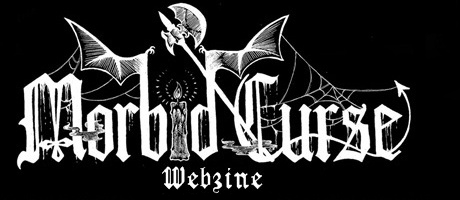
|

|

Impressions: The original Halloween is one of the most iconic
movies in the horror genre. It is also the film that renewed my interest in horror. I grew up with all of these movies, watching
everything from old Universal films to the various slasher movies that were popular when I was a kid. With no way to really
explore more of these classics, I got bored with watching the same ones, again and again, and refrained from watching any
for a few years. Then, in October 1996, I caught Halloween on cable and it was like seeing it for the first time,
all over again. It had been some years in between, and this completely reinvigorated me and fueled my desire to get back into
these movies that had long been so important to me.
 Plot summary: The film begins on Halloween night, 1963, when a six-year-old Michael
Myers, kills his older sister with a large kitchen knife. His parents arrive just afterward to find him in a trance. The boy
spends the next fifteen years at Smith's Grove Sanitarium, under the care of Dr. Sam Loomis. He spends the first several years
trying to reach out to Michael, but then realizes that nothing can be done for him and goes to great lengths to keep in in
custody. As he put it, he saw no remorse, no semblance of human conscious in the Michael. He claimed that he, "had the blackest
eyes; the devil's eyes". Plot summary: The film begins on Halloween night, 1963, when a six-year-old Michael
Myers, kills his older sister with a large kitchen knife. His parents arrive just afterward to find him in a trance. The boy
spends the next fifteen years at Smith's Grove Sanitarium, under the care of Dr. Sam Loomis. He spends the first several years
trying to reach out to Michael, but then realizes that nothing can be done for him and goes to great lengths to keep in in
custody. As he put it, he saw no remorse, no semblance of human conscious in the Michael. He claimed that he, "had the blackest
eyes; the devil's eyes".
We fast-forward to October 30th, 1978 as Myers escapes from the sanitarium and returns
to Haddonfield, in order to kill Laurie Strode. At this point, no one knows that she is his sister. This isn't revealed until
the sequel. Michael takes the jumpsuit from a truck driver that he murders and steals a Halloween mask and begins stalking
Laurie and her friends. He eventually goes through them, one by one, until the climax where he attacks Laurie. Being much
more resourceful than her friends, she manages to fight him off a few times. After stabbing him in the throat with a knitting
needle, she believes that he is dead. This is what audiences thought, back in 1978. Then, the horrifying realization comes
that he is no normal man. He gets up and continues his assault. Again, she thinks that she has defeated him, after jamming
a straightened-out wire hanger into his eye. In one of the most eerie scenes of the film, you see her weeping in the doorway,
as Michael rises in the background. Alerted by the screaming children, Dr. Loomis (who has been working with the sheriff,
all this time, in an attempt to track down his former patient) arrives just in time to shoot the masked killer. In fact, he
shoots him six times. However, the terror increases as Loomis looks to the ground below the balcony from which Myers fell,
only to discover that his body is not there. As the film ends, you get images of the various places where Michael had been,
throughout the movie, and you can hear him breathing. This gives the impression that he could be anywhere, or everywhere.
Conclusion: This is the movie that made John Carpenter a legend. Filmed
on a fairly tight budget, Carpenter and Debra Hill managed to create something very special that has endured the test of time.
A funny side note is that early screenings of the film weren't so favourable, since they lacked the incredible score music.
However, once this was added in, it really brought it all to life and added the final touch. If you haven't seen this movie,
then by all means do so. You don't know Halloween or Michael Myers until you've experienced this.
(8 Sept. 2009)

Impressions: This film was the second half of the one-two punch that
knocked me back into my senses and reignited the flame of horror that had long burned within me. While seeing Halloween,
for the first time in years, managed to open my eyes once again, it was Halloween II that finished the job. Just
a few weeks later, I woke up in the middle of the night and turned on the television, since I couldn't sleep. Lucky for me,
Halloween II was on cable that night. Though I'd grown up watching Michael Myers, I truly saw these films in a different
light, at this point. I'd say that this was a very critical juncture in my development, as I had just turned 16. Not only
was I discovering a lot of darker music, but I was reintroduced to the horror genre and was able to look at these movies in
a more in-depth manner. The first two movies of this series have left a lasting impact on me. 
Plot summary: Halloween II picks up from where the first
one left off. Dr. Loomis is quite troubled upon discovering that Michael's body is missing. He repeatedly tells the police
that he "shot him six times! He's not human! I shot him six times!" And, really, what we have here may be the birth of the
invincible slasher. In Halloween, he was stabbed and even shot, but we didn't get the full impression that we were dealing
with some supernatural evil. However, throughout the course of the second film, it becomes apparent that Michael Myers, in
fact, is no ordinary human.
Laurie is taken to Haddonfield Memorial Hospital, while Loomis and the Haddonfield
police are searching for Myers. At one point, they cause the death of a teenage boy that is dressed in a similar costume,
only to realize that it was not Michael, himself. Meanwhile, a bandaged and drugged up Laurie Strode (again, played by Jamie
Lee Curtis) is wandering through the hospital, which becomes more abandoned as the film progresses. Myers manages to murder
the entire late-night staff of the hospital, before finally tracking down Laurie.
A representative from Smith's Grove arrived in Haddonfield to get Dr. Loomis away from
the situation, but then told him that Laurie was Michael's little brother. Loomis was furious at the fact that information
had been kept from him, but then pieced together that Michael was in Haddonfield for the specific purpose of killing his sister,
thus finishing what he started all those years ago. Loomis and his police escort arrive at the hospital just in time to save
Laurie, though no one is there to save them. Again, Myers survives multiple gunshot wounds, and is only killed when Loomis
causes an explosion, seemingly killing them both.
Conclusion: Halloween II is much darker than the original,
partially due to the addition of Alan Howarth, working with John Carpenter on the score. Also, the cinematography is slightly
different, as it is obvious that they were going for a much darker atmosphere. Whereas the original spends a lot of time setting
up the story prior to the so-called action, this one wastes no time in going for the kill. Speaking of 'kills', there are
many more of them here and quite a bit more violence and blood. Possibly, the most evil scene in any of these movies comes
when the nurse discovers Dr. Mixter dead in his office. As her face is overcome by an expression of terror, you can see Michael
Myers, slowly, emerging from the shadows behind her. In this instance, he has an almost demonic presence. Worth mention is
that Halloween II was intended to be the end of the Michael Myers saga. The plan was to continue releasing a variety
of movies under the 'Halloween' name. It was only after the poor reception of Halloween III: Season of the Witch
and the strong desire from fans for the return of Myers, that he returned in 1988.
(9 Sept. 2009)
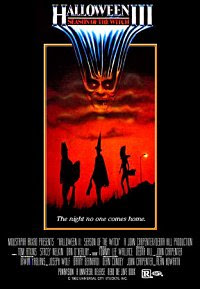
Impressions: Halloween III: Season of the Witch is, without
a doubt, the black sheep of the Halloween franchise. In a series that includes H20 and Resurrection,
that's a pretty impressive amount of hate. For a couple years, I even counted myself among those that simply 'didn't count'
this film, when speaking of Halloween. The funny thing is that it really seems to fit in a lot better than some realize, if
you follow the continuity up through Halloween: The Curse of Michael Myers.

Plot summary: The movie begins with a man being assaulted. He is taken
to the hospital, only to be followed by his assailants and murdered by a very familiar killer (yes, the same man that portrayed
Michael Myers in the original films). Dr. Challis attempts to apprehend the man, but is unable to reach him before he goes
out to his car and sets himself on fire, causing the car to explode. Dr. Challis teams up with the man's attractive daughter,
Ellie, as they search for clues as to what happened to her father. Their snooping leads them to Conal Cochran, who is the
owner of the Silver Shamrock Novelties factory. They lie about their identity, claiming that they are there to pick up an
order of Halloween masks, while staying in the local motel. The small company town is quite creepy, as it is under constant
surveillance and the human residents (it turns out that Cochran has created a legion of androids to work for him) are very
oppressed.
Once Ellie is kidnapped and Challis is captured in his effort to rescue her, it is
revealed that the Halloween masks contain a piece of a sacrificial stone, that was stolen from Stonehenge, that causes whoever
is wearing it to dissolve, spewing forth insects and snakes. This is triggered by the Silver Shamrock commercial that is set
to air on Halloween night. Cochran intends to revive the morbid aspects of the Celtic festival of Samhain, which he connects
to witchcraft. Challis is able to escape his bonds and to kill Cochran and his minions, though not before Ellie is turned
into one of them. He finally gets to a phone and begins calling the various television stations, in order to get the commercial
pulled from the air. He succeeds with the first two, but is too late to prevent it from airing on the third station. The film
ends with him screaming, "Stop it!"

Conclusion: No, Michael Myers is not present (though Dick Warlock
is here, and maintains the same aura about him, in a sense). However, this film is criminally underrated and dismissed as
worthless. Thanks in part to the continued collaboration with Alan Howarth, regarding the score, Halloween III: Season
of the Witch still maintains the same dark feeling as on Halloween II. The story is quite interesting as well,
which finds its way into Halloween lore in later years. Once you are able to get past the fact that this does not continue
the saga of Michael Myers, it is a quite enjoyable film. And, of course, there is one important factor that should be remembered:
this is one of the few times when good does not prevail over evil. Dr. Challis was unable to get the Silver Shamrock commercial
pulled from the third channel and, though it wasn't shown on screen, it is strongly implied that Cochran's plans succeeded
(posthumously) and millions of children died. Usually, the villain is always defeated and, even when this isn't the case,
children are rarely harmed. In this case, evil was victorious.
(9 Sept. 2009)
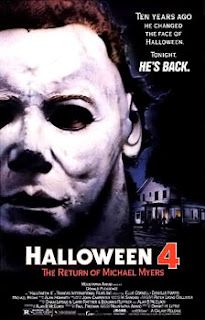
Impressions: Throughout the 1980s, many pretenders came and went,
striving for the vacant throne left behind when Michael Myers was vanquished back in 1981 (1978, in the context of the story).
The most notable among these was Friday the 13th and A Nightmare on Elm Street. Both movies turned out sequel
after sequel, becoming incredibly popular franchises within the horror community. Unfortunately, the quality of the aformentioned
films seemed to deteriorate with each release. Furthermore, neither one possessed the mystique and truly sinister aura that
belonged to their predecessor: Michael Myers.
The story of Michael Myers was one that was so utterly fascinating that fans were begging
for more, ever since he was 'killed off' in Halloween II. It was this obsession with his story, much more so than
any real problems, that resulted in the poor reaction toward Halloween III: Season of the Witch. They couldn't get
enough of The Shape, and who could blame them? Michael Myers set the standard for all slasher movies that were to follow;
however, the Halloween series transcends the what one would consider to be a simple slasher movie. 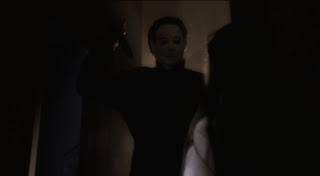
Seven years after Michael's last appearance, he was resurrected (as was the franchise),
to the delight and horror of his fans. Though I had watched the first two movies a handful of times by then, Halloween 4 was
the first one to really have any significant impact on me. Perhaps, the reason for this is that I saw this one in the theatre,
right around my 8th birthday. From this point on, the character of Michael Myers was of great importance to me. This didn't
turn into complete obsession until some years later, but it was at this point that I took notice and recognized this person
as far superior to those who had attempted to fill the vacuum that his absence had created. I also became quite fond of Danielle
Harris, at a young age, but that is another story.
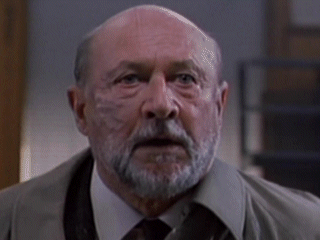 Plot summary: Ten years have passed since Michael Myers terrorized the small town
of Haddonfield. We discover that neither Michael nor Dr. Loomis died in the fire at the end of Halloween II. The former has
been in a comatose state, while the latter is permanently scarred and crippled. As it turns out, Laurie Strode has since died
in a car accident, though she left behind a young daughter, Jamie Lloyd. Myers awakens as he's being transported from one
facility to another and then proceeds to mercilessly slaughter those in the truck. He then begins to make his way back to
Haddonfield. The following day, this news makes its way to Dr. Loomis, who then tells his associates at Smith's Grove that
he knows where Michael is headed. After a brief encounter at a small gas station, Loomis continues on to the police station
where he attempts to warn them about the impending danger. Traumatized by the events of 1978, no one wants to believe that
it could all happen again. Plot summary: Ten years have passed since Michael Myers terrorized the small town
of Haddonfield. We discover that neither Michael nor Dr. Loomis died in the fire at the end of Halloween II. The former has
been in a comatose state, while the latter is permanently scarred and crippled. As it turns out, Laurie Strode has since died
in a car accident, though she left behind a young daughter, Jamie Lloyd. Myers awakens as he's being transported from one
facility to another and then proceeds to mercilessly slaughter those in the truck. He then begins to make his way back to
Haddonfield. The following day, this news makes its way to Dr. Loomis, who then tells his associates at Smith's Grove that
he knows where Michael is headed. After a brief encounter at a small gas station, Loomis continues on to the police station
where he attempts to warn them about the impending danger. Traumatized by the events of 1978, no one wants to believe that
it could all happen again.
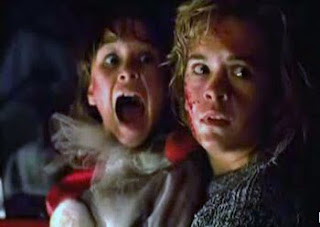 Meanwhile, Michael begins stalking his niece, Jamie, who has been adopted by the Caruthers family
and is in the care of her older step-sister, Rachel. The two have sort of a tense relationship, as Jamie's nightmares seem
to be putting a strain on things. Also, no teenager wants to blow off plans to babysit. After having to cancel her date plans
to take Jamie trick-or-treating, they go to pick up a costume for her. Ironically, she chooses a clown costume similar to
that worn by Michael the night he killed his older sister, Judith. That night, the terror begins. Meanwhile, Michael begins stalking his niece, Jamie, who has been adopted by the Caruthers family
and is in the care of her older step-sister, Rachel. The two have sort of a tense relationship, as Jamie's nightmares seem
to be putting a strain on things. Also, no teenager wants to blow off plans to babysit. After having to cancel her date plans
to take Jamie trick-or-treating, they go to pick up a costume for her. Ironically, she chooses a clown costume similar to
that worn by Michael the night he killed his older sister, Judith. That night, the terror begins.
Sheriff Meeker and Dr. Loomis search for Myers, as crack-technician, Bucky, gets tossed onto an electrical
box that manages to wipe out the power of the whole town. Meeker has a deputy set up shop at his home, where his daughter
and Rachel's boyfriend were getting friendly. Once they locate Jamie and Rachel (who had been separated while trick-or-treating)
they barricade them in his house while waiting for the state police. The sheriff has to go out in order to prevent his vigilante
citizens from trying to take matters into their own hands (some of them had lost family members, back in 1978, and end up
killing the wrong person in their quest to get even with Michael Myers). He manages to get into the house anyway, killing
everyone but Jamie and Rachel. They escape, making their way to the school and Dr. Loomis. Michael makes short work of him
and continues to follow them as they flee in a truck full of rednecks. Michael kills them all, forcing Rachel to drive, and
is then thrown from the truck. She takes aim and drives right into him, propelling him backward into what appears to be a
small graveyard. Jamie gets close to him, as the state police arrive, touching his hand. Though he was trying to kill her,
she feels some strange connection to him. As he rises to finish what he started, Jamie jumps out of the way and the police
open fire on him, sending him into a mine shaft. They follow this by tossing some sort of explosives in behind him, presuming
to have finished him off.
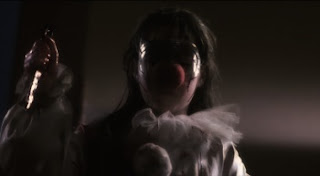 Back at the house, Jamie puts on her clown mask and proceeds to stab her step-mother with a pair of
scissors. As Dr. Loomis and Sheriff Meeker rush to the bottom of the stairs, after hearing the woman's screams, they gasp
in horror at the sight of Jamie standing there with the bloody scissors. Loomis attempts to shoot her, knowing that she is
possessed by the evil of Michael Myers, but the sheriff prevents this. Back at the house, Jamie puts on her clown mask and proceeds to stab her step-mother with a pair of
scissors. As Dr. Loomis and Sheriff Meeker rush to the bottom of the stairs, after hearing the woman's screams, they gasp
in horror at the sight of Jamie standing there with the bloody scissors. Loomis attempts to shoot her, knowing that she is
possessed by the evil of Michael Myers, but the sheriff prevents this.
Conclusion: Halloween 4: The Curse of Michael Myers was very successful
in rejuvenating this near-dead franchise. There were enough similarities with the original to maintain the same feeling (Rachel
acting as the baby-sitter, Loomis teaming up with the sheriff to stop Myers before it's too late, the sheriff's daughter being
murdered, etc.) while also adding a new dimension to the story. This is aided, greatly, by the strong characters in the film.
As opposed to the endless stream of cookie-cutter victims put to death by Jason Voorhees, the characters in this film are
all well-defined and do a great job in drawing the audience in and giving them a reason to care. In particular, Danielle Harris
does a phenomenal job of carrying this movie, along with Donald Pleasance. It's very rare that a child actor can pull off
something like this, but she exceeds any and all expectations that anyone could have possibly had for a girl her age. The
theme does well to tie things together, as well, since Alan Howarth returned to work on the score. While nothing will ever
surpass the first two films of this series, Halloween 4 proved to be one of the most successful of them all and remained
true to the story. If you haven't seen this, the season os approaching. Do yourself a favour and remedy the situation.
(12 Sept. 2009)
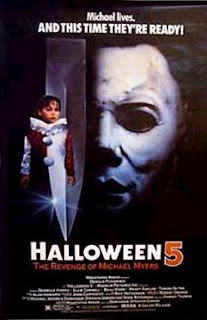
Impressions: Upon being reborn in 1988, the Halloween series built
up a great deal of momentum. They wasted no time in getting to work on a sequel and, furthermore, they planted the seeds for
the follow-up to that as well. Halloween 5: The Revenge of Michael Myers goes from feeling like the continuation
of the story began in Halloween 4: The Return of Michael Myers to seeming like a build-up for something bigger. At
the time, many fans were expecting the possibility of a sequel that focused on Jamie as the killer, as the 'revenge' in the
title could have been taken any number of ways. This is what Danielle Harris was thought was going to happen. Thankfully,
they realized that horror fans craved more of the Shape, and didn't attempt to pass the torch. 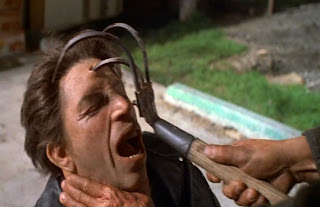
This one came out a few weeks before my 9th birthday and, again, I was fortunate enough
to see it in the theatre. Even early on, I didn't care too much for some of the characters in the film. I found Tina to be
very annoying and couldn't wait for her to finally die. The two idiot cops brought with them a completely unwanted sense of
comedy relief. As I have come to understand it, the script wasn't entirely finished when they began shooting and some things
were changed in the middle of the process. Despite some minor complaints, and a generally watered-down feeling, this film
is a welcome addition to the Halloween franchise. 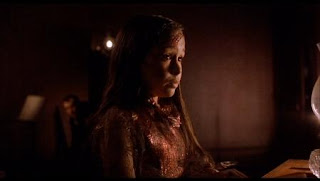
Plot Summary: The movie begins by recapping the end of the previous
film. We see Michael get blasted by the state police, only to fall down a mine shaft and get transported down a stream. He's
nursed back to health by an old hermit (oddly), whom he kills upon waking up, one year later. In the meantime, Jamie is a
mute that has been institutionalized after stabbing her step-mother. She seems to have some telepathic link to Michael, and
she desperately tries to warn of his coming. After Michael goes on a killing spree, Loomis and the police use Jamie as bait
to lure him back to the old Myers house. Eventually, he gets Loomis and Jamie alone in the house, after hanging the one officer
that was protecting her, out the window. There's a touching scene where Jamie attempts to reach out and connect with Michael
(at this point, she had regained her ability to speak). He shows some sign of relenting, and a tear rolls down his cheek.
She tries to comfort him, but this fills him with rage and he continues with his mission to kill her. She escapes and he then
meets with a brutal beating from Dr. Loomis. Of course, this was set up by shooting Myers with a couple tranquilizers. All
the while, we've seen minimal shots of a figure dressed in black, arriving in Haddonfield. With Myers locked in a cell, the
sheriff calls for the National Guard to come take him away, but the man in black shoots up the police station and causes and
explosion. Jamie, who was waiting in a car outside, walks through the ruins of the police station to see all of the officers
dead and she is horrified to realize that Michael has escaped. The film ends with her echoing cries, "Nooooo".
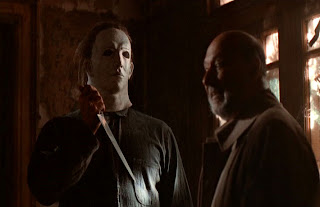
Conclusion: At the time, this was one of the weaker films in the
Halloween franchise. There are some annoying elements, but the overall atmosphere is there. In the end, its greatest success
is that it did a great job of creating interest in the next movie. Unfortunately, it took six years for Halloween 6: The
Curse of Michael Myers to follow up on this and, when it did, the version that was released in theatres made no sense.
Still, Donald Pleasance and Danielle Harris both did an incredible job of carrying this movie. As a matter of fact, the two
most powerful scenes of the film involved Danielle, one being the aforementioned attic scene with Michael and the other being
the eerie realization that he was on the loose again, at the end. Ultimately, this ranks beneath most of its predecessors,
as well as the p-cut of Halloween 6, but it's still superior to anything that came out post-1995.
(4 October 2009)
Halloween: The Curse of Michael Myers (1995)
Halloween: The
Curse of Michael Myers was the final installment of the original series, prior to the first reboot. Of course, at the
time of the release of Halloween: H20, I just could not grasp why they broke the continuity and disregarded the
previous sequels. While I still think that film (and the one that followed) should never have been made, I can see why the
creative forces behind this franchise felt the need to do this. I've long said that the theatrical release of Curse...
was a mess and I'd always recommended that people seek out a copy of the producer's cut (henceforth referred to as the p-cut).
Thanks to someone on the old Horrorspeak message board, I'd gotten my hands on a third-generation copy just a few years later
and found it to be vastly superior to the theatrical version. That said, seeing it again for the first time in several years,
I can only conclude that even the better of the two is, in itself, a convoluted mess.

Curse... had
the unenviable task of making sense of the whole Man in Black thing, as well as the thorn tattoo, from Halloween 5: The
Revenge of Michael Myers. Many years ago, I thought it was interesting and liked the continuity (even though, really,
they could have done nearly anything with those vague elements), as well as the explanation involving the runes and the cult.
Now I look at all of this and can only wonder why they felt the need to make it all so complicated. And to think of the ending
of the previous film, some stranger rescuing The Shape from jail, mowing down cops with a machine gun... what the hell did
this have to do with the Halloween series? As this movie explains, the cult somehow controls Michael Myers, and he is bound
by the curse of thorn to murder all of his family members. That covers why he killed his sister in the original, why he was
after Lauri, as well as her daughter, Jamie. So why not his parents, also? Or how about his aunts and uncles? And then, once
the cult has possession of Jamie (not played by Danielle Harris in this one, which is another strike against the film in the
eyes of most fans), why not kill her immediately? Why would they keep her alive for years, only to then force Michael to rape
her so that she would become pregnant and give birth to his child? His task would have been complete had he just killed her
in 1989, rather than waiting until she'd given birth to yet another blood relative that he would have to chase down and kill.
Also, why on earth would Dr. Wynn want to somehow transfer guardianship of Michael to Dr. Loomis, who was equally as old and
decrepit? There is so much that just does not hold up under scrutiny. The real answer is that no one knew quite what they
wanted. Rather than having a solid movie idea and then proceeding to make it, Moustapha Akkad simply wanted to make more money
off of the character that he owned and there existed a production schedule even before an acceptable script had been written.
Even then, the script went through various re-writes.

The p-cut includes
more of the real Halloween theme, rather than the stupid pop rock that kept popping up in the theatrical version. This made
quite a difference as far as creating the proper atmosphere. The movie as it was originally shot was far more pleasant than
the garbage that was released in the theatres, and didn't just go off the rails into a total crash of confusion and
nonsense at the end. It has more success in holding things together and at least attempting to follow the tangled plot offered
here. I certainly would not call it a waste of time, but would also offer that this franchise would have done well to end
with Halloween 4: The Return of Michael Myers.
This is what happens when such characters are overexposed, and when writers try to give too
much of a backstory and explanation to the motives of a killer. A lot of fans hate that Michael was portrayed as a mere tool
for this cult, under their control. It definitely neuters him, to a degree. A character that began as the personification
of pure evil has been reduced to a mere henchman of sorts. Again, if you're going to watch this one, stick to the p-cut. But
in all honesty, though they're both infinitely better than the totally worthless H20 and Resurrection (and the
white trash car wreck remakes from Rob Zombie), neither Revenge... nor Curse... really live up to the previous
entries.
(15 October
2013)
Return to index
|

|

|

